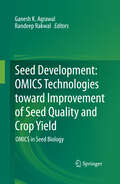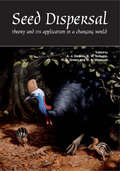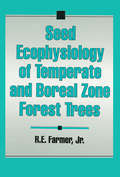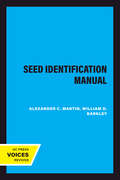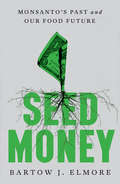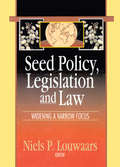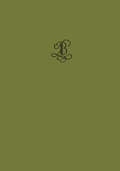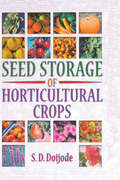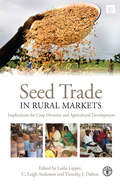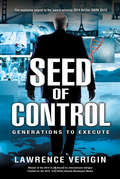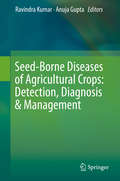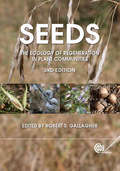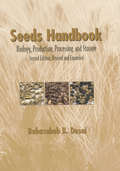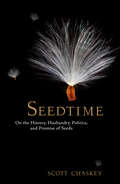- Table View
- List View
Seed Development: OMICS Technologies toward Improvement of Seed Quality and Crop Yield
by Ganesh K. Agrawal Randeep RakwalThe book is about the seed development in the model and crop plants. Seed development is a key step of the plant life cycle that determines the nutrient value of seeds - the life for human civilization, growth, and development. The nutrient value of seeds is mainly due to storage reserve products such as carbohydrates, lipids (triacylglycerols), and proteins. The book primarily focuses on application of the 21st century high-throughput technologies transcriptomics, proteomics, metabolomics, and systems biology in near complete understanding of the various processes involved in seed development in different crop plants. The book reveals how such technologies have revolutionized our understanding of the multilayer processes and regulations involved therein by generating large-scale datasets. Accumulated datasets provide basic knowledge to develop integrated strategies to eventually improve the nutritional value of plant seed and crop yield, a critical goal in food security issues around the globe.
Seed Dispersal: Theory and Its Application in a Changing World
by Andrew J. Dennis Eugene W. Schupp Ronda J. Green David A. WestcottFresh concepts in the study of seed dispersal are spurring a host of exciting new answers, answers to old questions, new methods and approaches, and a reinvigoration of the field. Seed Dispersal: Theory and its Application in a Changing World present both recent advances and reviews of current knowledge, demonstrating the vigour and vibrancy of the field.
Seed Ecophysiology of Temperate and Boreal Zone Forest Trees
by RobertE. FarmerThis is the first truly modern book solely devoted to seed reproduction of forest trees-from flowering to establishment, with emphasis on the interaction of environment with physiological processes.Focus is on seed function in natural settings and the application of information to natural regeneration of forests. This easy-to-read text addresses important principles and provides in-depth coverage of existing literature.Presentation of the information is organized to allow for a natural development of the main theme with full explanations of such important components as seed production, dispersal and germination, as well as the integral parts played by water, temperature, light, chemicals, animals, pathogens and aging.A highly useful book for investigators, practitioners or students.
Seed Identification Manual
by Alexander C. Martin William D. BarkleyThis title is part of UC Press's Voices Revived program, which commemorates University of California Press’s mission to seek out and cultivate the brightest minds and give them voice, reach, and impact. Drawing on a backlist dating to 1893, Voices Revived makes high-quality, peer-reviewed scholarship accessible once again using print-on-demand technology. This title was originally published in 1961.This title is part of UC Press's Voices Revived program, which commemorates University of California Press’s mission to seek out and cultivate the brightest minds and give them voice, reach, and impact. Drawing on a backlist dating to 1893, Voices Revived</DIV
Seed Libraries: And Other Means of Keeping Seeds in the Hands of the People
by Cindy ConnerHistorically, seed companies were generally small, often family-run businesses. Because they were regionally based, they could focus on varieties well-suited to the local environment. <P><P>A Pacific Northwest company, for example, would specialize in different cultivars than a company based in the Southeast. However the absorption of these small, independent seed businesses into large multinationals, combined with the advancement of biotechnology resulting in hybrids and GMO seeds, has led to a serious loss of genetic diversity. The public is now at the mercy of the corporations that control the seeds.In the past few years, gardeners have realized the inherent danger in this situation. A growing movement is striving to preserve and expand our stock of heritage and heirloom varieties through seed saving and sharing opportunities. Seed Libraries is a practical guide to saving seeds through community programs, including: Step-by-step instructions for setting up a seed library A wealth of ideas to help attract patrons and keep the momentum going Profiles of existing libraries and other types of seed saving partnershipsWhoever controls the seeds controls the food supply. By empowering communities to preserve and protect the genetic diversity of their harvest, Seed Libraries is the first step towards reclaiming our self-reliance while enhancing food security and ensuring that the future of food is healthy, vibrant, tasty, and nutritious.Cindy Conner is a permaculture educator, founder of Homeplace Earth and producer of two popular instructional gardening DVDs. She is also the author of Grow a Sustainable Diet.
Seed Money: Monsanto's Past And Our Food Future
by Bartow J. ElmoreAn authoritative and eye-opening history that examines how Monsanto came to have outsized influence over our food system. Monsanto, a St. Louis chemical firm that became the world’s largest maker of genetically engineered seeds, merged with German pharma-biotech giant Bayer in 2018—but its Roundup Ready® seeds, introduced twenty-five years ago, are still reshaping the farms that feed us. When researchers found trace amounts of the firm’s blockbuster herbicide in breakfast cereal bowls, Monsanto faced public outcry. Award-winning historian Bartow J. Elmore shows how the Roundup story is just one of the troubling threads of Monsanto’s past, many told here and woven together for the first time. A company employee sitting on potentially explosive information who weighs risking everything to tell his story. A town whose residents are urged to avoid their basements because Monsanto’s radioactive waste laces their homes’ foundations. Factory workers who peel off layers of their skin before accepting cash bonuses to continue dirty jobs. An executive wrestling with the ethics of selling a profitable product he knew was toxic. Incorporating global fieldwork, interviews with company employees, and untapped corporate and government records, Elmore traces Monsanto’s astounding evolution from a scrappy chemical startup to a global agribusiness powerhouse. Monsanto used seed money derived from toxic products—including PCBs and Agent Orange—to build an agricultural empire, promising endless bounty through its genetically engineered technology. Skyrocketing sales of Monsanto’s new Roundup Ready system stunned even those in the seed trade, who marveled at the influx of cash and lavish incentives into their sleepy sector. But as new data emerges about the Roundup system, and as Bayer faces a tide of lawsuits over Monsanto products past and present, Elmore’s urgent history shows how our food future is still very much tethered to the company’s chemical past.
Seed Policy, Legislation and Law: Widening a Narrow Focus
by Neils P LouwaarsLearn what it takes to create and implement a truly successful seed policy!This unique book brings together international experts on seed policy and law. While other books approach the subject from the perspective of seed industry development and privatization, Seed Policy, Legislation, and Law makes clear that a successful national seed
Seed Quality: Basic Mechanisms and Agricultural Implications
by Robert E GoughSeed Quality: Basic Mechanisms and Agricultural Implications focuses on various aspects of seed quality and integrates research at basic and applied levels, supporting high-quality seeds as the basis of higher agricultural productivity. With its clear perspective and interdisciplinary focus on basic and applied aspects of seed quality, this book is immensely useful to students and teachers in many agricultural and botanical disciplines.Because seed quality is a critical component in the economic considerations of the farmer and the seedman alike, Basra looks in-depth at these aspects of seed production:seed viabilityseed healthseed vigorseed testingvariety identificationcrop yieldseed storageseed productionseed deteriorationseed treatmentsSeed quality is of international agronomic concern, and the recent upsurge of interest in seed quality has accentuated a new awareness regarding its importance in crop production. This book meets the need for information and could form the basis of long-range planning by policymakers on quality assurance and management programs and in the facilitation of international trade. Researchers, students, and teachers in many agricultural and botanical disciplines--seed science and technology in particular--will find this book to be of immense use. It can be used as a handbook for those involved in seed industry and seed testing services. It is recommended for international courses in seed science and technology and seed training programs.
Seed Regeneration in Cross-pollinated Species
by E. PorcedduThis book deals with the practical aspects in regeneration of field crop plants; regeneration of pasture plants; and regeneration of horticultural plants. It discusses the methods to increase seed stocks of cross-pollinated species.
Seed Storage of Horticultural Crops
by S.d. DoijodeMaintain viability with these techniques for proper seed storage!Healthy, viable seeds are the foundation for sustainable crop production, while poorly kept seeds can result in low germination and crop loss. Seed Storage of Horticultural Crops suggests appropriate strategies to help farmers and breeders store seeds of all kinds.
Seed Trade in Rural Markets: Implications for Crop Diversity and Agricultural Development
by Leslie Lipper Leigh Anderson Timothy J. DaltonMarkets have been found to be an increasingly important source of the seeds of crops and varieties low income farmers need to improve their livelihoods, encompassing both the formal and informal seed sector. Markets also have major impacts on agricultural biodiversity, by affecting farmers' choice of crops and varieties to grow. They are not, however, a homogenous institution, although all too frequently policies and regulations are developed as though they were. Markets vary considerably depending on the participants, on the institutions that govern how and what they exchange, and on local agricultural, economic and social conditions. Developing effective strategies to improve the way agricultural markets work, including how farmers use crop genetic resources, requires understanding of these variations. Seed Trade in Rural Markets presents a unique set of case studies from Bolivia, India, Kenya, Mali and Mexico on agricultural seed and product markets that describe three important market characteristics expected to affect farmers' access to seeds and varieties: the range of varieties on offer, the information provided about them, and relative prices. The case studies - all based around a common framework to aid comparability - also provide information on social, agricultural and economic factors which may be affecting the market availability, information, and cost of crop genetic resources, and ultimately the capacity to stimulate agricultural development Published with the Food and Agriculture Organization (FAO) of the United Nations
Seed of Control: Generations to Execute
by Lawrence VeriginSeed of Control is the explosive sequel to the award-winning, high-concept thriller Dark Seed. Exposé author Nick Barnes is back, finding himself quickly thrown into a chain of events which uncovers a plot so beyond moral comprehension that it will affect Earth s entire population. The plot has taken generations to develop and in on the cusp of being fully implemented. Agri-industrialist Dr. Hendrick Schmidt and media baron Davis Lovemark lead the villainous plot with the unerring belief that they are the stewards of humanity and that they alone have the right to decide the fate of the masses.
Seed-Borne Diseases of Agricultural Crops: Detection, Diagnosis & Management
by Ravindra Kumar Anuja GuptaThe global population is increasing rapidly, and feeding the ever-increasing population poses a serious challenge for agriculturalists around the world. Seed is a basic and critical input in agriculture to ensure global food security. Roughly 90 percent of the crops grown all over the world are propagated by seed. However, seed can also harbour and spread pathogens, e.g. fungi, bacteria, nematodes, viruses etc., which cause devastating diseases. Seed-borne pathogens represent a major threat to crop establishment and yield. Hence, timely detection and diagnosis is a prerequisite for their effective management. The book "Seed-Borne Diseases of Agricultural Crops: Detection, Diagnosis & Management" addresses key issues related to seed-borne/transmitted diseases in various agricultural crops. Divided into 31 chapters, it offers a comprehensive compilation of papers concerning: the history of seed pathology, importance of seed-borne diseases, seed-borne diseases and quarantine, seed health testing and certification, detection and diagnosis of seed-borne diseases and their phytopathogens, host-parasite interactions during development of seed-borne diseases, diversity of seed-borne pathogens, seed-borne diseases in major agricultural crops, non-parasitic seed disorders, mechanisms of seed transmission and seed infection, storage fungi and mycotoxins, impact of seed-borne diseases on human and animal health, and management options for seed-borne diseases. We wish to thank all of the eminent researchers who contributed valuable chapters to our book, which will be immensely useful for students, researchers, academics, and all those involved in various agro-industries.
Seeds
by Robert S GallagherThe 3rd edition of Seeds: The Ecology of Regeneration in Plant Communities highlights the many advances in the field of seed ecology and its relationship to plant community dynamics that have taken place in recent years. The new edition also features chapters on seed development and morphology, seed chemical ecology, implications of climate change on regeneration by seed, and the functional role of seed banks in agricultural and natural ecosystems. The book is aimed at advanced level students and researchers in the fields of seed science, seed ecology and plant ecology.
Seeds Handbook: Processing And Storage
by Babasaheb B. DesaiRevised and expanded throughout, this latest edition of the bestselling Seeds Handbook: Biology, Production, Processing, and Storage includes valuable information on all areas of seed biology, production, and processing. The author, one of the most respected and prolific scientists in the field, identifies current developments in seed testing and c
Seeds and Sovereignty: Debate Over the Use and Control of Plant Genetic Resources
by Jack R. Kloppenberg Jr.Seeds for economically important crops are big business indeed. As large seed companies continue to improve their product in various ways, they make use of the original gene pools of these plants, often located in tropical and subtropical areas of the world. With increasing recognition that plant germplasm is an important raw material, highly charged international disputes have developed over the exchange and use of this material, adding another point of contention between poor nations and the manufacturing wealthier ones. Twenty experts from several nations, representing both the natural and social sciences, consider the historical background, the issue of patent rights as applied to plant germplasm, the nature of global genetic interdependence, the internationalization of the seed industry, the implications of biotechnology on genetic resources, the Third World attitude toward the debate, and the viewpoints of the International Agricultural Research Centers.
Seeds for Diversity and Inclusion: Agroecology and Endogenous Development
by Yoshiaki Nishikawa Michel PimbertThis open access book will contribute to a more nuanced debate around seed system resilience that goes beyond the dominant dichotomous conceptualization of seed governance often characterized as traditional vs modern, subsistence vs commercial, or local vs global. While reflecting on the expanding oligopoly in the current seed system, the authors argue that such classifications limit our ability to critically reflect on and acknowledge the diverse approaches through which seed governance is practiced around the world, at various scales, creating a mosaic of dynamic complementarities and autonomies. The authors also highlight the importance of this much needed dialogue through case studies of seed governance approaches and practices found in and around Japan.
Seeds: The Ecology of Regeneration in Plant Communities
by Robert S. GallagherThis 3rd edition highlights many advances in the field of seed ecology and its relationship to plant community dynamics over recent years. It features chapters on seed development and morphology, seed chemical ecology, implications of climate change on regeneration, and the functional role of seed banks in agricultural and natural ecosystems.
Seedtime: On the History, Husbandry, Politics and Promise of Seeds
by Scott ChaskeyScott Chaskey—working farmer, poet, and spiritual father of the community farming movement—considers "the web of biodiversity and resilience at the heart of our cultural inheritance" by masterfully weaving history, politics, botany, literature, mythology, and memoir into a beautiful and instructive book.It's hard to think of a subject more fundamental to the sustenance of the human race than seeds. Having coevolved with the Earth's plants, insects, and animals, seeds are entwined with the core myths of ancient cultures and the development of human consciousness. Their story remains vitally important today, as the corporations that manufacture GMOs threaten our food security and the future of seed-cultivated agriculture.The stakes, for those concerned with preserving biodiversity and ecological integrity, are high. Balancing a wide view of politics and history, Chaskey alights from life on the farm he has cultivated for 25 years to conjure Gregor Mendel's breeding experiments that yielded our modern understanding of genetics; he also introduces us to several "bioneers," such as the geobotanist Nikolay Vavilov and agriculturalist Cary Fowler, who are preserving global biodiversity through seeds. Integrating scholarship with accessible storytelling, Seedtime is a celebration as well as a call to action urging us to renew our role as citizens of nature, in ecologist Aldo Leopold's phrase, not as conquerors of it.
Seeing Autism through Parents’ Feedback, Sketchnotes, Technology, and Evidence-based Practices (Educational Communications and Technology: Issues and Innovations)
by Demetria Ennis-ColeSeeing Autism is a comprehensive but easy-to-understand guidebook for caretakers, parents, educators, counselors, therapists, and researchers on various aspects of rearing and supporting children with autism spectrum disorder. It provides textual and visual information on technology tools, symptoms, diagnosis, auditory, sensory, visual, physical, and educational issues, as well as strategies and practices to help children on the Autism Spectrum reach their potential. Seeing Autism uniquely capitalizes on sketchnotes, a visual thinking tool, to communicate information and practices. Sketchnotes provide a unique space that can help the reader think differently, generate a variety of ideas, explore alternatives, and develop constructive points for expressing ideas and developing visual communication aids. This book will assist parents, educators, and professionals in schools (counselors, school psychologists, librarians) who work with children diagnosed with ASD; it will help readers increase their knowledge of autism and gain an appreciation for evidence-based practices and forms of technology that can be used to support learners on the autism spectrum. “This book is a call to arms and is as much a resource for the family friend as it is for the provider coming to the home. In the book Seeing Autism, Dr. Demetria Ennis-Cole helps individuals gain an incredible perspective and learn the struggles, challenges and joys of families rearing children, teens and adults on the spectrum. This book covers the entire spectrum and is a fantastic mix of research, parent perspective, and even sketchnotes for visual learners. The material is well-balanced and is a great resource to support individuals on the spectrum at home, in the community or in the classroom." Brad McGarryFather, Speaker, Author and Director of the Autism Initiative at Mercyhurst University
Seeing Invisible: Advanced Antenna Arrays (River Publishers Series in Communications and Networking)
by Pavlo A. MolchanovThis book provides a simple explanation of existing antenna arrays, their advances and limitations. It will lead you to nature-inspired next generation antenna array design and their advances.Why antenna arrays? Because antennas or antenna arrays are the primary element in any sensory system or circuit. Any artificial intellect, computer, vision, communication, or detection system cannot work properly without a properly designed sensor system or antenna array. They include not only technical areas like communication, navigation and radars, but also health care, medical imaging and even amateur metal detectors and RC vehicle design.Taking into account today’s military and geo-political threats, the book will also help you understand the functional needs of the new generation of antenna arrays for various radar and anti-missile systems to meet those threats. It also covers the evolution of antennas and antenna array design and gives insight into the fundamental function and advances of nature inspired new generation, fly eye antenna arrays and their applications.This book is intended for a wide area of readers and does not require special education, but it is a valuable resource for engineers and technicians who are involved in the design and development of all space communication and navigation systems, and drones, and hypersonic missiles detection systems, with special emphasis on interference immunity and protection. It also can be used as a textbook in advanced radar technology coursework and seminars.
Seeing Space
by Robert A. CroneSpatial vision is a subject in which philosophy, psychology, ophthalmology, neurophysiology and pathology meet. It is the unique contribution of this book that gives a survey of the whole subject, in historical perspective. The author, a former professor of ophthalmology at the University of Amsterdam, is an authority in the field of binocular visi
Seeing Through the Eighties: Television and Reaganism
by Jane FeuerThe 1980s saw the rise of Ronald Reagan and the New Right in American politics, the popularity of programs such as thirtysomething and Dynasty on network television, and the increasingly widespread use of VCRs, cable TV, and remote control in American living rooms. In Seeing Through the Eighties, Jane Feuer critically examines this most aesthetically complex and politically significant period in the history of American television in the context of the prevailing conservative ideological climate. With wit, humor, and an undisguised appreciation of TV, she demonstrates the richness of this often-slighted medium as a source of significance for cultural criticism and delivers a compelling decade-defining analysis of our most recent past. With a cast of characters including Michael, Hope, Elliot, Nancy, Melissa, and Gary; Alexis, Krystle, Blake, and all the other Carringtons; not to mention Maddie and David; even Crockett and Tubbs, Feuer smoothly blends close readings of well-known programs and analysis of television's commercial apparatus with a thorough-going theoretical perspective engaged with the work of Baudrillard, Fiske, and others. Her comparative look at Yuppie TV, Prime Time Soaps, and made-for-TV-movie Trauma Dramas reveals the contradictions and tensions at work in much prime-time programming and in the frustrations of the American popular consciousness. Seeing Through the Eighties also addresses the increased commodification of both the producers and consumers of television as a result of technological innovations and the introduction of new marketing techniques. Claiming a close relationship between television and the cultures that create and view it, Jane Feuer sees the eighties through televison while seeing through television in every sense of the word.
Seeing What's Next
by Clayton M. Christensen Scott D. Anthony Erik A. RothEvery day, individuals take action based on how they believe innovation will change industries. Yet these beliefs are largely based on guesswork and incomplete data and lead to costly errors in judgment. Now, internationally renowned innovation expert Clayton M. Christensen and his research partners Scott D. Anthony and Erik A. Roth present a groundbreaking framework for predicting outcomes in the evolution of any industry. Based on proven theories outlined in Christensen's landmark books The Innovator's Dilemma and The Innovator's Solution, Seeing What's Next offers a practical, three-part model that helps decision-makers spot the signals of industry change, determine the outcome of competitive battles, and assess whether a firm's actions will ensure or threaten future success. Through in-depth case studies of industries from aviation to health care, the authors illustrate the predictive power of innovation theory in action.
